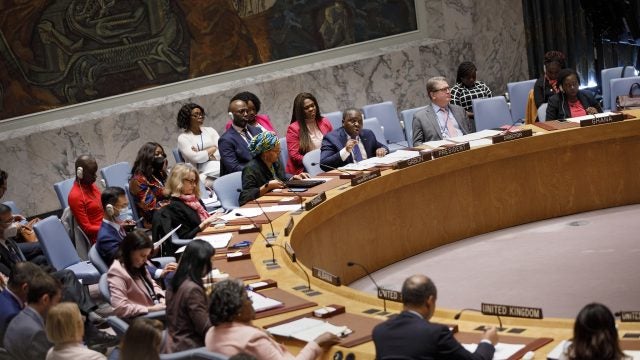
Title: The Georgetown Journal’s Guide to Occupy Nigeria: Why Hawkers Love a Traffic Jam
Early warning systems in 2010 showed that Nigeria remains one of four potential hotspots for conflict within West Africa. Conflict in Nigeria has several different sources of contention: oil in the Niger Delta; religious violence in the North; the expansion of Boko Haram’s increasingly frequent terrorist activities; and most recently, nationwide protests and strikes over the ending of fuel subsidies.
In 2007 the CIA predicted that by 2015 Nigeria would either become a failed state or, following Sudan’s recent example, split into more than one country (separating the North and South, and maybe even East ala the Nigerian-Biafran Civil War of 1967-1970).
At a projected growth rate of 55 million people by 2025, Nigeria has the second largest youth bulge in the world, a demographic feature associated with the emergence of political violence and civil conflict. The fragility of peace in Nigeria has become ever more apparent during the past year.
On January 1 2012, President Goodluck Jonathan ended all fuel subsidies, providing a spark for an already tenuous security situation. Overnight, oil prices more than doubled from 65 naira (USD $0.40) to 140 naira per liter, causing drastic increases in food, transportation and energy costs. In a county where citizens cannot count on their government to help provide basic needs or social amenities like public transportation or a functioning electrical supply, this was seen as unacceptable. Outraged citizens took to the streets starting nationwide “Occupy Nigeria” movements, mass protests and strikes. The situation escalated to violence, and many states issued 24-hour curfews.
Protests took place in Lagos, Kano and Abuja. In Port Harcourt, Nigeria’s oil capital, protesters marched along concrete pillars, originally laid out as part of a monorail project, but which now serve as a sad reminder of the governments’ inability to follow-through on its promises.
On the other side, there were also some demonstrators in support of the ending of subsidies, who argued that this was a necessary move to combat corruption. Rumor has it that many of these demonstrators were those selling black market fuel, and therefore profited from the ending of the subsidy. The Yoruba people (one of the three largest ethnic groups in Nigeria) have a saying here: “Awon onikiri gbadun sunkere fakere” (hawkers love a traffic jam), expressing the local belief that there is always someone who is profiting from a negative situation.
On January 12, President Jonathan entered negotiations with leaders from the National Labour Congress (NLC). A few days later, the NLC announced that a portion of the fuel subsidy would be reinstated, reducing the price to 97 naira per liter. By January 17, the Occupy Nigeria movement was over.
With millions of demonstrators agitating throughout the country on any given day, why didn’t this movement achieve its stated goal of full reinstitution of the fuel subsidy?
First, the involvement of the NLC resulted in a “professionalization” of the Occupy Nigeria movement. Big men in fancy cars rolled up to what had previously been a grass-roots movement. Instead of dancing and singing anti-government chants, protesters aimlessly waited around through speech after long-winded speech. Many wandered off or went home, not bothering to return for subsequent protests.
Second, protests were suspended over weekend periods, causing the movement to lose momentum and cynics to claim that the protests were simply an excuse for “those lazy people” to take a vacation from work.
Third, there was a lack of co-ordination between different cities, resulting in isolated movements, unclear goals and means for obtaining those goals, and a disunited and disorganized front.
Relatedly, degrees of adherence to non-violent techniques varied greatly and hindered the movement. Violence from protesters was used to justify retributive and even proactive violence from security forces under the guise of “defense.” Protesters in Port Harcourt were relatively peaceful, but in Lagos they were burning public and private property. Abuja was practically shut-down, and Kano was forced to enact a 24-hour curfew.
Despite failing to reach its objective, Occupy Nigeria was not a complete failure. It has set the stage for subsequent movements and expanded Nigerians’ knowledge of nonviolent tools to bring about change. It has put civil society members in touch with each other, creating networks for future mobilization. The lessons learned from Occupy Nigeria will inform future social movements and help them to be more successful. (For more, see Meyer and Whittier’s “Social Movement Spillover.”)
Furthermore, the Occupy Nigeria movement engaged previously marginalized groups. In the city of Kano in North Nigeria, hijab-wearing women took to the streets for the first time.
Lastly, although the CIA’s prediction reflects a grim outlook, the Occupy Nigeria movement showed that there are still some issues that can unify the country. Protests crossed socio-economic, ethnic and religious lines. This could be the first step in working together for a better Nigeria.
. . .
Valerie Oliphant is a masters student in the Conflict Resolution program at Georgetown University. She is currently living in Nigeria as a 2011-2012 Boren Fellow.
Image credit: Kolawole Oreoluwa, CC BY-SA 4.0, via Wikimedia Commons
This is an archived article. While every effort is made to conserve hyperlinks and information, GJIA’s archived content sources online content between 2011 – 2019 which may no longer be accessible or correct.
Recommended Articles

This article explores the uncertain future of Arctic governance amid shifting global geopolitics. It argues that whether Washington and Moscow opt for confrontation or cooperation, multilateralism in the Arctic…

Twenty-five years ago, the United Nations Security Council adopted Resolution 1325, establishing a framework that underpins the Women, Peace, and Security (WPS) Agenda. The Resolution recognized both the…

When we analyze conflicts in the Middle East, we are not analyzing conflicts with isolated impacts but risks for global energy security. Recent conflicts in the Middle East have highlighted…